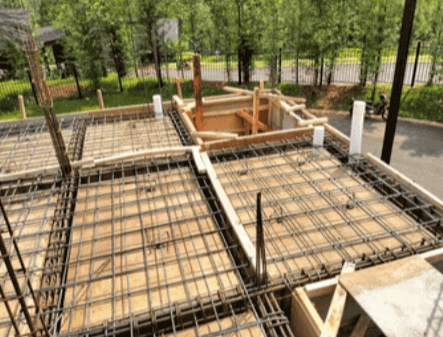What is a tie beam in a house? A tie beam in a house is a horizontal structural element that connects columns to reduce their effective length and improve load distribution across the foundation. This vital component helps distribute loads evenly and plays a crucial role in preventing structural failures. Read on as we delve into the specifics of what a tie beam in a house is, its functions, and why it is indispensable for ensuring the longevity and safety of your home.
Real estate investors Steve Daria and Joleigh stress the importance of understanding critical structural components like tie beams when evaluating a property’s construction quality. According to them, a well-designed tie beam not only enhances load distribution but also contributes to the overall resilience of the building. Steve and Joleigh are confident in their investments’ long-term stability and value by ensuring these elements are in place.
What is a Tie Beam?
A tie beam in a house is a horizontal structure that attaches two or more vertical elements, like columns or walls, to ensure the stability of a building.
Found near the foundation, between floors, or at roof levels, tie beams play a critical role in maintaining the integrity of a structure.

Types of Tie Beams
Different types of tie beams serve various functions:
- Ground Tie Beams: Located at the foundation level to distribute loads.
- Plinth Tie Beams: Found at the plinth level, providing additional support to walls.
- First-Floor Tie Beams: Used between the first and second floors for added stability.
- Roof Tie Beams: Located at the roof level to stabilize the roof structure.
Materials Used
Tie beams can be constructed from various materials, including concrete, steel, and wood.
Every material presents distinct advantages and is selected based on the particular needs of the structure.
Get An Offer Today, Sell In A Matter Of Days...
The Purpose of Tie Beams in a House
Explore the essential purpose of a tie beam in a house.
Load Distribution
One primary function of a tie beam in a house is to evenly distribute the load across different columns and walls.
By sharing the weight, tie beams prevent any single point from becoming overly stressed, reducing the risk of structural failures.
Resistance to Lateral Forces
Tie beams are essential in resisting lateral forces caused by wind, earthquakes, or other external pressures.
They help maintain the building’s overall stability by preventing the walls and columns from shifting out of alignment.
Foundation Support
At the foundation level, tie beams connect the base of the columns, ensuring that the load is evenly transferred to the soil.
This support helps prevent the foundation from settling unevenly, which can lead to cracks and some structural issues.
Benefits of Using Tie Beams
Here are the benefits of using tie beams to ensure your house’s structure is strong.
Enhanced Structural Integrity
Incorporating tie beams into a house design significantly enhances the building’s structural integrity.
By providing additional support and stability, tie beams reduce the risk of deterioration and prolong the lifespan of the property.
Cost-Effective Construction
While adding tie beams to a construction project may seem like an extra expense, it can save money in the long run.
Tie beams help prevent costly repairs and maintenance by ensuring the building’s stability and reducing the risk of structural issues.
Improved Safety
Tie beams contribute to the overall safety of a building by providing additional support and resistance to lateral forces.
This added stability is crucial in regions prone to natural disasters like earthquakes and hurricanes.
Strategies for Effective Tie Beam Implementation
Discover these practical strategies for effective tie beam implementation.
Proper Placement
To maximize the benefits of tie beams, it’s essential to place them strategically within the structure.
Consult with a structural engineer to get the optimal locations for tie beams based on the specific requirements of your building.

Quality Materials
Using high-quality materials for tie beams is crucial to ensure their effectiveness and longevity.
Invest in durable materials like reinforced concrete or steel to provide the necessary support and stability.
Regular Maintenance
Like any other structural component, tie beams require consistent maintenance to ensure they remain in good condition.
Inspect tie beams periodically for indication of wear or damage and point out any issues promptly to prevent further deterioration.
Frequently Asked Questions
Explore the most common queries about a tie beam in a house.
What is the difference between a tie beam and a plinth beam?
While both tie beams and plinth beams provide additional support to a structure, they serve different purposes.
A tie beam connects columns and walls to ensure stability, while a plinth beam provides support at the plinth level, helping distribute loads evenly across the foundation.
Can tie beams be used in all types of buildings?
Yes, tie beams can be used in various structures, including residential, commercial, and industrial buildings.
Their primary function is to enhance stability and support, making them a valuable addition to any construction project.
How do I know if my house needs tie beams?
Work with a structural engineer to determine if your house requires tie beams.
They will assess your building’s specific needs and recommend the best course of action to ensure its stability and safety.
Conclusion
Understanding the importance of a tie beam in a house is crucial for real estate investors, house buyers, property sellers, and land buyers. Tie beams play a vital role in enhancing structural integrity, distributing loads, resisting lateral forces, and supporting foundations. By incorporating tie beams into your construction projects, you can make sure the stability and safety of your buildings, ultimately saving time and money in the long run.
If you’re considering a new construction project or looking to invest in real estate, consult with a structural engineer to determine the best tie beam solution for your needs. With the right strategy and materials, you can produce a solid foundation for your future success.
**NOTICE: Please note that the content presented in this post is intended solely for informational and educational purposes. It should not be construed as legal or financial advice or relied upon as a replacement for consultation with a qualified attorney or CPA. For specific guidance on legal or financial matters, readers are encouraged to seek professional assistance from an attorney, CPA, or other appropriate professional regarding the subject matter.

